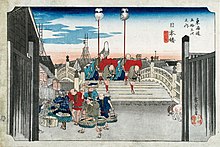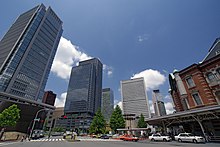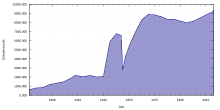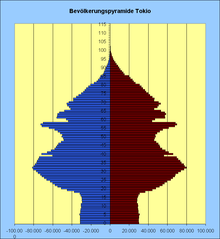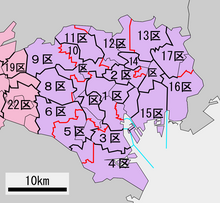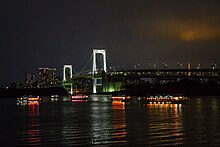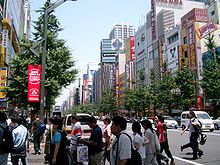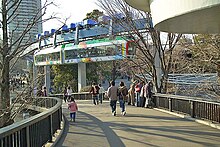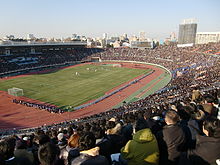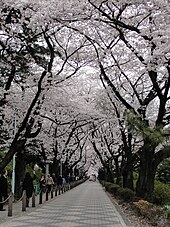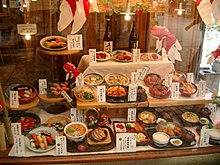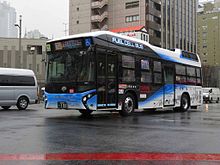Tokyo
|
Japanese 東京 Tokyo |
||
|---|---|---|
|
|
||
| Coordinates | 35 ° 41 ′ N , 139 ° 46 ′ E | |
| Basic data | ||
| Country | Japan | |
| region | Kantō | |
| Tokyo | ||
| ISO 3166-2 | JP-13 | |
| height | 6 m | |
| area | 628 km² | |
| Metropolitan area | 13,572 km² | |
| resident | 9,640,742 (March 1, 2021) | |
| Metropolitan area | 38,505,000 (2019) | |
| density | 15,351.5 Ew. / km² | |
| Metropolitan area | 2,837.1 Ew. / km² | |
| Postal code | 100-xxxx – 179-xxxx | |
|
From top to bottom (left to right): Shinjuku and Fuji-san skyscrapers , Tokyo Skytree , Rainbow Bridge and Akasaka in the background, Shibuya , Parliament building
|
||
Tokyo (also Tokyo , Japanese 東京 Tōkyō [ to̞ːkjo̞ː ] ) is a global city in the Kantō region in the east of the Japanese main island of Honshū . With 9,640,742 inhabitants, it is not only the most populous metropolis in the country, but also part of the capital area of Japan as the seat of the Japanese government and the Tennō . It comprises the 23 districts in the area of the city of Tokyo , which was abolished as an administrative unit in 1943, and is therefore no longer a separate local authority; instead, the districts together with the cities and towns of the western Tama region and the southern Izu and Ogasawara Islands form the Tokyo Prefecture . This in turn forms the center of the Tokyo-Yokohama metropolitan area , in which more than 38.5 million people live (as of 2019), which makes the region the largest metropolitan area in the world.
The city's history begins in 1446 when Ōta Dōkan began building Edo Castle in a swamp area on the north bank of today's Tokyo Bay , surrounded by a few fishing villages. In 1590 this castle went to Tokugawa Ieyasu , who founded his new shogunate and thus the Edo period here after his victory in the Battle of Sekigahara . Edo became the political and cultural center of the country alongside Kyoto . With the Meiji Restoration in 1868, the shogunate was abolished and the seat of the Tenno moved to Edo, the castle became the imperial palace and Edo got its new name Tokyo, which means "Eastern Capital". From then on, the city's population also grew, which by 1910 was one of the largest in the world with around two million inhabitants. During the Second World War , Tokyo was exposed to numerous air raids by the USA, in which around half of the city's area was destroyed. After the end of the American occupation , there was a rapid economic upswing, accompanied by a renewed population increase.
Today Tokyo is the industrial, commercial, educational and cultural center of Japan with numerous universities, colleges, research institutes, theaters and museums. With Narita and Haneda airports and the starting point for most Shinkansen lines, it is also the country’s transportation hub. The Tokyo financial center is not only the largest in Japan, it is also one of the five largest in the world alongside London, New York and Hong Kong. In addition, the city has a high price level and was ranked 9th most expensive cities worldwide in a 2014 study. In addition to modern sights such as the Tokyo Tower or Tokyo Skytree , it also offers historical facilities such as the Imperial Gardens in Chiyoda , Ueno Park or the Asakusa-Kannon Temple . In recent years Tokyo has become an increasingly popular tourist destination and is among the top 20 most visited cities, with up to eight million foreign visitors annually. In a ranking of cities according to their quality of life, Tokyo ranked 50th out of 231 cities worldwide in 2018.
geography
Geographical location
Tokyo is located on the Tokyo Bay on the island of Honshū, the largest of the four main islands of the Japanese archipelago , in the Kantō Plain ( Kantō-heiya ) an average of six meters above sea level . Kantō is the area that lies in a wide arc around Tokyo Bay. The name Kantō means "east of the barrier" - a historical name. ( Kansai , meaning “west of the barrier”, is the area around Osaka .) “Barrier” refers to the old customs border that separated western Japan from eastern Japan , west of the city of Hakone .
The Kantō level is the largest level in Japan. Due to earlier, massive volcanic eruptions in the Fujisan , which was rather quiet in the last centuries , almost the entire plain was covered with fertile, volcanic ash - the so-called kantō rōmu sō . Then there is the large Tokyo Bay, which is deep enough to function as a harbor and shallow enough to wrest larger areas from the sea.
Definition and size of Tokyo
In the administrative sense, there is no city of Tokyo. Urban area within the meaning of this article are the 23 districts of Tokyo . Their area is 621.98 square kilometers. They form the urban core of the metropolitan area and are located on the area of the former city of Tokyo , which was dissolved as a political unit in 1943. Each district (Japanese区 ku ) is administratively an independent municipality. Officially, the districts are called City in English (e.g. Shinjuku City , Shibuya City ).
The Tokyo Prefecture (Japanese東京 都 Tōkyō-to ; English Tokyo Metropolis ) includes not only the 23 districts but also the western part of the metropolitan area, up to the foothills of the Japanese Alps , the Tama region . The prefecture also includes the Izu Islands and Ogasawara Islands in the south of the Pacific, as well as Okinotorishima . The prefecture has over 13 million inhabitants and extends to the Tropic of Cancer .
Although Tokyo (in the sense of the 23 districts) already has more than nine million inhabitants, the city itself is surrounded by metropolises with a population of millions, Saitama in the north, Chiba in the east and Yokohama and Kawasaki ( Kanagawa Prefecture ) in the south. In the west joins the Tama region with four million inhabitants.
Together, these cities and their environs form the Tokyo metropolitan area . In Japan, the area is called Tokyo area (東京 圏, Tōkyō-ken ), capital area (首都 圏, Shuto-ken ) or South Kantō (南 関 東, Minami-Kantō ). The different names denote different definitions for the boundaries of the metropolitan area, which generally includes the Tokyo Prefecture itself, but excluding the Pacific Islands, and completely or partially the neighboring prefectures of Chiba , Kanagawa and Saitama , as well as smaller parts of Gunma , Ibaraki and Tochigi , and even Yamanashi . The metropolitan region covers 13,572 km² and has around 37.555 million inhabitants (2014). The metropolitan area around Tokyo forms the largest metropolitan area in the world .
The 23 districts of Tokyo
The area of the former city of Tokyo with its 35 districts, i.e. the urban core area of Tokyo, has been filled with 23 districts (区 -ku ) since 1947 , which largely function as independent municipalities:
climate
The city is located in the area of the subtropical east side climate (after Neef ). According to the Köppenscher climate classification, the city can be assigned to the warm temperate maritime climate . The summers are hot and humid (30 ° C during the day and 20 ° C at night), the winters dry and sunny (10 ° C during the day and around 0 ° C at night); sometimes snow also falls. The rainy season (Tsuyu) with daily rain showers lasts from late June to mid-July. It is caused by damp trade winds from the western Pacific. Afterwards - from mid-July to the end of August - it is consistently hot with high humidity.
Typhoons threaten in September or October, but rarely last longer than a day. They usually arise in summer or early autumn in the North Pacific west of the date line and north of the 5th parallel north on the edge of the Kalmengurtel and then mostly migrate first northwest towards Vietnam , the Philippines and China . If they fail to reach the mainland, they will turn northeast and haunt Korea and Japan . In Tokyo, typhoons bring strong gusts of wind and rain , but then gradually weaken the further they penetrate inland, as they no longer absorb water.
The average annual temperature in Tokyo is 15.6 ° C, the average annual rainfall is 1466.8 millimeters. The warmest month is August with an average of 27.1 ° C, the coldest is January with an average of 5.2 ° C. Most of the precipitation falls in September with an average of 208.5 millimeters, the least in December with an average of 39.6 millimeters.
| Tokyo | ||||||||||||||||||||||||||||||||||||||||||||||||
|---|---|---|---|---|---|---|---|---|---|---|---|---|---|---|---|---|---|---|---|---|---|---|---|---|---|---|---|---|---|---|---|---|---|---|---|---|---|---|---|---|---|---|---|---|---|---|---|---|
| Climate diagram | ||||||||||||||||||||||||||||||||||||||||||||||||
| ||||||||||||||||||||||||||||||||||||||||||||||||
|
Average monthly temperatures and rainfall for Tokyo
Source: Japan Meteorological Agency; wetterkontor.de
|
|||||||||||||||||||||||||||||||||||||||||||||||||||||||||||||||||||||||||||||||||||||||||||||||||||||||||||||||||||||||||||||||||||||||||||||||||||||||||||||||||||||||||||||||||||||||||||||||||||
earthquake

Tokyo is located in one of the most active earthquake zones in the world. Small earthquakes are not unusual in the city. During the very active phases, small, noticeable earthquakes can occur almost daily. Despite all their efforts, scientists have not yet succeeded in making an effective earthquake forecast.
One of the most famous theories comes from Kawasumi Hiroshi, President of the Institute for Earthquake Research at the University of Tokyo. He has analyzed all earthquakes in Tokyo since 818 with a magnitude of over 5 on the Richter scale and determined that on average one major earthquake occurs every 69 years. So the next big quake should have come in 1992. However, this is a purely statistical calculation that does not take geological conditions into account and is therefore completely unsuitable for short-term forecasting. Ishibashi Katsuhiko from the University of Kobe took a much more differentiated view . According to him, the earthquakes always occur in a certain cycle. At the beginning there are several smaller quakes; a big tremor then always marks the end of this cycle.
One of the most severe earthquakes was the Great Kantō earthquake with a magnitude of 7.9, in which around 140,000 people died and around 380,000 houses were destroyed in Tokyo and Yokohama on September 1, 1923. Further severe earthquakes occurred in 1615 (magnitude 6.4), 1649 (7.1), 1703 (8.2), 1855 (6.9) and 1894 (7.0). In the Genroku earthquake on December 31, 1703 Tokyo (then: Edo) and other cities in the area were destroyed. Over 10,000 people were killed in the region.
story
origin
As archaeological finds show, the urban area was already settled in the Stone Age. Originally, Tokyo was a small fishing port under its former name Edo . Around the year 1457, the daimyō Ōta Dōkan had a castle built near the village. The settlement only gained importance in 1590 when it passed into the possession of the Shogun Tokugawa Ieyasu (1543-1616).
Edo period
Tokugawa Ieyasu made Edo the capital of the Shogunate , the real power in Japan, in 1603 , while the powerless Tennō (Emperor) continued to reside in the official capital, Kyoto . The Edo Castle was restored and expanded during his reign. The area around Edo Castle was known as Yamanote .
Tokyo has often been hit by devastating earthquakes and large fires. In 1657, for example, a major fire claimed several thousand lives and destroyed more than 60 percent of what was then the city. The Shogunate used this opportunity to reorganize the city structures, which mainly served to prevent fires and to strengthen the defenses of Edo Castle. During this phase, shrines and temples were systematically transported to the outskirts and townspeople were relocated to newly built outskirts.
Tokugawa Ieyasu's order to his daimyo to build his own residences in Edo, where their families were practically held hostage ( Sankin-kōtai disposal ) , led to a faster growth of the city . Numerous craftsmen and merchants who were needed to supply the court settled in Edo at the beginning of the 18th century.
Meiji period until World War II
In 1868, at the instigation of Meiji-Tennō ( Mutsuhito , 1852-1912), the imperial court was relocated to Edo and the city was renamed東京for “eastern capital” or more precisely “imperial capital in the east”. At that time, the characters were partly read in the Han-sounding Tōkei , and sometimes already in the Wu-sounding Tōkyō (Tokyo).
In 1872 a major fire destroyed the districts of Ginza and Marunouchi . The reconstruction and the associated modernization of the cityscape were carried out according to the western model. The planning for this was entrusted to an English architect who wanted to shape the cityscape with a mixture of European styles (streets based on Parisian style and construction of the houses based on the London model). Despite a certain ambivalence among the population about the completely new, western buildings, which conveyed a more closed feeling of living, the then governor of the Tokyo prefecture Yuri Kimimasa had craftsmen and builders come to Tokyo to start the work. In the Ginza district in particular, the reconstruction should begin as soon as possible, since a railway line between Yokohama and Shimbashi was to be inaugurated there. Moving traditional homes and warehouses to side streets made room for the new architecture.
The worst natural disaster in the recent history of Tokyo was the Great Kanto earthquake and fire of September 1, 1923, in which much of the city was destroyed. The reconstruction, which was completed in 1930, resulted in over 200,000 new buildings, including many based on western designs, as well as seven reinforced concrete bridges over the Sumida River and some parks.
In 1943, with the decree of Tōkyō-tosei, the city of Tokyo was dissolved as an administrative unit. During World War II , the United States began bombing Tokyo on November 24, 1944 , and American bombers also carried out heavy air raids on February 25 and March 10, 1945. More than 100,000 people died when entire districts with buildings in traditional wooden construction were destroyed in flames . On an area of 15 square miles (approx. 39 square kilometers) all houses were destroyed, including the historic imperial palace.
Post-war until today
During the occupation , Tokyo was occupied by American troops from September 1945 to April 1952. The associated tensions erupted in the bloodily suppressed demonstrations on May 1, 1952 . General Douglas MacArthur , who headed the occupation authorities as Supreme Commander for the Allied Powers, resided opposite the Imperial Palace . Especially from the beginning of the Korean War , the city experienced a period of rapid reconstruction and economic growth.
From October 10 to October 24, 1964, the XVIII. Summer Olympics take place.
On March 20, 1995, members of the Ōmu Shinrikyō (Aum sect) carried out a sarin attack on the Tokyo subway . Thirteen people died and 6,252 were injured.
According to Forbes' 2009 list of the World's Most Expensive Cities To Live , Tokyo is considered the most expensive city in the world. In March 2013, the Forbes list named Tokyo second (behind Hong Kong ).
On September 7, 2013, Tokyo was selected by the International Olympic Committee (IOC) to host the 2020 Summer Olympics , which had to be postponed to 2021 due to the COVID-19 pandemic .
outlook into the future
For the near future, seismologists predict a devastating earthquake in Tokyo on the scale of the Great Kanto earthquake of 1923. This and the exorbitant land prices are the reasons why a relocation of the capital away from Tokyo has been discussed and planned since the 1990s - capital relocations have often occurred in Japanese history for religious and political reasons. On the basis of a law from 1992, three candidate regions were identified by 1999: Tochigi - Fukushima in the northeast, Gifu - Aichi in Tōkai and Mie - Kiō . So far, no activities have taken place.
Population development

Tokyo has had a population of more than one million since the 1880s. Since the late 1940s, the Tokyo metropolitan area has grown rapidly again, both in terms of area and population. About a quarter of the total population of Japan lives in it. Its outer limit is between 40 and 70 kilometers from the city center. After an interim high in 1965, the population of the 23 districts had decreased, but is currently increasing again due to reurbanization and has meanwhile also exceeded the level of 1965.
The 23 districts together have 9,640,742 inhabitants (as of March 1, 2021). The Tokyo metropolitan area, together with the neighboring prefectures of Kanagawa , Saitama and Chiba, forms the largest contiguous urban area on earth with 37.4 million inhabitants (2017). The metropolitan area is home to 27 cities with populations over 200,000, 17 cities with populations over 300,000, and eight cities with populations over 500,000.
Tokyo has three more metropolises as suburbs: Yokohama , Saitama and Kawasaki . About 900,000 people live in the eastern suburb of Chiba . With 3.6 million inhabitants, Yokohama in the south of Tokyo has about the same number of inhabitants as Berlin or Madrid .
The following overview shows the population of the former city of Tokyo, i.e. the area of today's 23 districts, according to the respective territorial status. Up to 1914 these are estimates, from 1920 to 2005 they are census results.
|
|
|
Population development in the metropolitan area
According to United Nations figures, the metropolitan area's population grew from 11.3 million in 1950 to over 37.4 million in 2017. The metropolitan area of Tokyo is the largest in the world. An increase in the population is expected until 2020. A population of 32.6 million people is assumed for 2050, which means that Tokyo would lose its status as the world's most populous agglomeration. In 2100 a population of 25.6 million is expected.
Population development of the agglomeration according to the UN
| year | population |
|---|---|
| 1950 | 11,275,000 |
| 1960 | 16,679,000 |
| 1970 | 23,298,000 |
| 1980 | 28,549,000 |
| 1990 | 32,530,000 |
| 2000 | 34,450,000 |
| 2010 | 36,860,000 |
| 2017 | 37,397,000 |
politics

There is no common political structure exclusively for Tokyo. Joint administrative tasks for Tokyo are carried out directly by the superordinate Tokyo Prefecture ( Tōkyō-to , English Tokyo Metropolis ) based in the Tokyo Metropolitan Government Building in Shinjuku . The 23 districts therefore have a unique status among the municipalities of Japan as tokubetsu-ku (“special” or “special districts”). They work together through some joint institutions such as the “Special District Mayors' Conference” in various areas such as organizing horse races or recruiting local officials; a number of these city-wide institutions have their headquarters in Tōkyō kusei kaikan (about "House of Tokyo District Politics ") in Iidabashi in the Chiyoda district .
Attempts by some politicians, e.g. For example, in the 2000s, an attempt by Shigefumi Matsuzawa and Kiyoshi Ueda , the then governors of the neighboring prefectures of Kanagawa and Saitama, to build up a close, joint administrative structure for the Tokyo metropolitan area , have so far been without any concrete result. Existing cooperation forums are the regional conference of governors Kantō ( Kantō chihō chijikai ) of ten governors of the region and the kyū-tokenshi-shunō-kaigi (about "Conference of the heads of administration of nine prefectures and cities", sometimes shutoken summit ), which the governors of the prefectures Saitama, Chiba, Tokyo and Kanagawa as well as the mayors of the cities of Yokohama, Kawasaki, Chiba, Saitama and Sagamihara gathered.
On maps, also by government agencies, Tokyo is still often marked as a whole as the capital of the Tokyo prefecture, even if, from a purely technical point of view, it can no longer be since the city was dissolved as an administrative unit in 1943; Since the prefectural administration moved in 1991, the Shinjuku “special district” has been the seat of the prefectural administration. Looking at Tokyo as the prefecture capital, of all 47 prefecture capitals it is the one with the highest proportion of the prefectural population - more than two thirds of the population of Tokyo live in the 23 districts; so it would be well ahead of the city of Kyoto , where around 56% of the residents of the Kyoto Prefecture live. If, on the other hand, only existing communities are taken into account, Shinjuku is the prefecture capital with less than 3% with the lowest proportion of the prefectural population.
| period | Tokyo administration | Reason for change, comments |
|---|---|---|
| until 1868 | 2 shogunate administrations (bugyōsho) for Edo | The three capitals Edo, Osaka and Kyōto and a number of other important cities were controlled as shogunate cities by city administrators (machi-bugyō) directly from the shogunate. |
| Jul. – Sept. 1868 | Edo Prefecture (Edo-fu) | Merger of the Shogunate administrations after the surrender of Edo and subordination to the new imperial government |
| 1868-1871 |
Tokyo Prefecture (Tōkyō-fu) (excluding short-term exclaves) |
renamed with the emperor's move |
| 1871-1878 | 6 "large districts" of Tokyo Prefecture (further subdivided into 97 "small districts" (shōku) ) |
Division of the prefectures into “large districts” (daiku) [in Tokyo prefecture after the enlargement eleven] Enlargement of Tokyo prefecture by parts of neighboring prefectures adjusted for previous feudal ex- / enclaves (especially Setagaya and the surrounding area as exclave of Hikone prefecture in the Shinagawa Prefecture) |
| 1878-1889 | 15 urban districts / districts ( ku ) of Tokyo prefecture | Division of the prefectures into [initially only six in Tokyo prefecture] districts ( gun ) and urban districts (ku) |
| 1889-1932 |
[district-free] city of Tokyo (Tōkyō-shi) (divided into 15 districts (ku) ) |
Division of the prefectures into modern parishes (shi / chō / son) [in Tokyo Prefecture 1893 over 150] until 1898, Tokyo was ruled as an immediate city without an independent administration: the governor of the Tokyo prefecture was also mayor of the city of Tokyo. |
| 1932-1943 |
[district-free] city of Tokyo (Tōkyō-shi) (divided into 35 districts (ku) ) |
"Greater Tokyo": incorporation of 82 municipalities = five complete districts of the Tokyo prefecture, 20 new urban districts |
| 1943-1947 | 35 now prefecture-immediate districts ( ku ) | Tōkyō-tosei : abolition of the city of Tokyo, more direct control of the imperial government over the prefecture of Tokyo |
| since 1947 | 23 “Special Districts” ( tokubetsu-ku ) of Tokyo Prefecture | Reorganization of the districts, democratization, but no restoration of the city of Tokyo, but introduction of the status of "special districts" with comparable rights to self-government as other municipalities (after the end of the occupation period again partially restricted) |
Elections and voting weight
Eleven of the 23 Tokyo district mayors and 20 of the 23 local parliaments are elected in the “uniform regional elections” in years before leap years (most recently in 2019 ). In elections to the parliament of the Tokyo prefecture , the districts of Tokyo still have 87 of the total of 127 MPs after the 2017 election , with the 23 districts serving as SNTV constituencies, but having very different voting weights: In the 2009 election , the district's almost 40,000 eligible voters voted Chiyoda one MP, the second highest voting weight in the prefecture after the Izu and Ogasawara Islands. In contrast, over 500,000 eligible voters elected five MPs in the Edogawa district , with over 100,000 eligible voters per MP the fourth lowest voting weight out of three constituencies west of Tokyo.
In the national lower house , the districts of Tokyo comprise 17 of the total of 25 individual constituencies of the Tokyo prefecture , one of which also contains the Pacific islands belonging to the Tokyo prefecture. Here, too, the weight of the votes varies, but is generally low compared to the rest of the country: in 2009 there were over 400,000 eligible voters per member of parliament in most of the constituencies of Tokyo, while the more rural, westernmost constituency of Tokyo prefecture only had around 320,000 eligible voters - for comparison: In 2009 there were fewer than 250,000 eligible voters in each of seven constituencies in Shikoku .
Only in gubernatorial and national upper house elections does the voting weight of the residents of the Tokyo districts not differ from the rest of Tokyo Prefecture, since the entire prefecture forms a constituency.
Culture and sights
theatre
Tokyo has many theaters that perform both traditional forms of theater - such as Nō and Kabuki - and modern plays. Several symphony orchestras and many smaller orchestras have Western and traditional Japanese music in their repertoire.
Near the Tokyo Opera City Tower in the Shibuya district is the New National Theater ( Shin kokuritsu gekijō ), which is in the theaters Opera Gekijō ("Opera House"; English Opera Palace ), Chū-gekijō ("Middle Theater", Play House ) and Shō -gekijō ("Little Theater", The Pit ) shows operas, ballet and contemporary dance. The Tokyo concert hall with symphonic music is also located in Opera City . The Suntory Hall is a concert hall in the Akasaka district, it is one of the world's most renowned concert halls. In partnership with several European theaters, the Panasonic Globe Theater shows western dramas. The Takarazuka Grand Theater is a theater for revues and musicals and the home of the music theater group Takarazuka Revue . Nō and Kabuki are performed in numerous smaller theaters in the city.
In the national theater in Hayabusachō mainly performances of traditional Japanese theater forms are given.
Museums
The Tokyo National Museum , the largest and oldest museum in Japan, is located in Ueno Park in the Taitō district . Around 110,000 exhibits of Japanese art and archeology are shown. Other major art museums include the National Museum of Western Art , Tokyo Metropolitan Teien Art Museum , Artizon Museum, and the National Museum of Modern Art .
The National Museum of Natural Sciences , founded in 1871, shows a selection of the 3.5 million individual items, including a collection on science before the opening of Japan . The Edo Tokyo Museum and Fukagawa Edo Museum deal with the history of the city of Tokyo. There, the old Tokyo was recreated in miniature, individual historical houses are also shown in their original size.
The Tokyo Subway Museum has existed since 1986.
Buildings


The historic city center of Tokyo in the Chiyoda district is dominated by the Kōkyo Imperial Palace . The imperial residence is located on the former site of Edo Castle and is surrounded by an extensive park. In the Nagatachō district to the south and west of the palace complex is the government district with the official seat of the Prime Minister ( Kantei ), the building of the Japanese Parliament and the Supreme Court .
To the east of the imperial palace is the Marunouchi district , the country's most important business district . Many of Japan's major corporations and a large number of financial institutions have their headquarters here. In 1914, this district gained great importance after the opening of the main train station . Tokyo's largest shopping district is to the east of Marunouchi. It extends from the Nihombashi district in the north to Ginza in the south. Many department stores, international fashion brands, traditional specialty shops, entertainment venues and restaurants have settled along the streets of these districts.
In the Minato district is the 333-meter-high Tokyo Tower , one of the city's landmarks, and the Tokyo Midtown high-rise complex . Another retail and business center is the Shinjuku district around Shinjuku Station , which is also home to major corporate headquarters and the prefectural government. Other important city centers and sights are Akihabara , also known as Electric City (電 気 街, denki-machi ), a large electronics and computer shopping district and meeting place for the otaku , the Tsukiji fish market (largest fish market in the world), the Tokyo Dome , the Ueno -Park with the monorail Ueno Zoo , the Mitsukoshi department store and the Rainbow Bridge . In the Sumida district , the Tokyo Sky Tree was completed on March 18, 2011 , although the Tohoku earthquake also reached Tokyo the week before . The opening took place on May 22, 2012. At 634 meters, the tower is the tallest television tower in the world and the second tallest free-standing structure after the Burj Khalifa in Dubai, Arabia .
Important sacred buildings are the Meiji Shrine and the Sensō-ji in Taitō , the oldest temple in Tokyo.
Parks
Even if the impression of a dense urban landscape with little green predominates in Tokyo, there are over a hundred public parks in the urban area, although a playground with a few trees is considered a park. The largest inner-city parks in Tokyo are Ueno Park in Taitō , Yoyogi Park and Shinjuku Gyoen , followed by Shinjuku Chūō Park , Hibiya Park and the green spaces around the Imperial Palace (namely Ni-no-Maru-Park , Kita-no-Maru-Park , Chidori-ga-Fuchi-Park and Soto-Bori-Park ).
Other parks are the Inokashira Park between the cities of Musashino and Mitaka , the Koishikawa-Kōrakuen , a landscape garden on the property of a former daimyō property right next to the Tokyo Dome , and the Odaiba-Kaihin Park , a popular meeting place for couples with a view of the Tokyo Bay. The most famous amusement parks in Tokyo are Tokyo Sea Life Park , Hanayashiki , Toshimaen , Tokyo Disney Resort , Tama Zoo and Ueno Zoo .
The Tama Zoo is the largest zoo in Tokyo. It was opened on May 5, 1958 and covers an area of 52.3 hectares. The zoo is divided into three ecological areas, the Asian garden, the African garden and the Australian garden. He also owns an insectarium . In the respective gardens, typical animals of the respective continent are shown. It is located in front of the Tama Dōbutsu Kōen station on the Keiō-Dōbutsuen line and the Tama monorail .
The Ueno Zoo is the oldest animal park in Japan. It is smaller than the Tama Zoo and is located in Ueno Park in the middle of downtown Tokyo. The zoo is divided into two parts by a road in a cut, which is connected by a bridge and the Ueno-Zoo Monorail .
The "Hama Rikyū Garden" at the mouth of the Sumida , originally the garden of the imperial villa, is known for its seawater pond, which also has ebb and flow, and its bridges overgrown with wisteria . The “Kiyosumi Garden” got its present form from Baron Iwasaki in 1878. A small pond with around 10,000 carp is surrounded by large rocks that come from all over Japan. In 1924 it was given to the city of Tokyo. Also worth seeing are the parts of the beautiful mountain landscape of the Chichibu-Tama-Kai National Park located further to the west, behind the suburbs .
Sports
In addition to the sport of sumo , whose tournaments are held in Tokyo in January, May and September at the Ryogoku Kokugikan , baseball and soccer are very popular in Japan. Tokyo is home to the " New York Yankees of Japan", the record champions Yomiuri Giants , and the Tōkyō Yakult Swallows - both from the Central League . The Yokohama DeNA BayStars play in the greater area and the Chiba Lotte Marines and Saitama Seibu Lions play in the Pacific League . J1 League football teams from Tokyo are FC Tokyo and Tokyo Verdy , and record champions Kashima Antlers , JEF United Ichihara Chiba , Yokohama F. Marinos , Urawa Red Diamonds , Kawasaki Frontale , Ōmiya Ardija and Kashiwa Reysol also come from the region .
The traditional sports such as Aikidō , Judo , Karate , Kyūdō and Kendō can mostly only be visited in the respective schools at certain times. If you want to jog in Tokyo, you will find many like-minded people at the moat around the Imperial Palace.
Several Olympic buildings, including the Olympic Stadium and the Yoyogi Arena, are located near the Meiji Shrine. The sports facilities were built on the occasion of the Olympic Games in 1964 according to plans by the architect Kenzō Tange (1913-2005). The 2020 Olympic Games will take place in Tokyo.
Regular events
Every year at the beginning of April, the cherry blossoms ( sakura no hana ) open in Tokyo . They symbolize beauty, perfection, but also transience at the height of fame. The people in Japan therefore revere the pale pink splendor as a symbol of a short but fulfilled life. The cherry blossom is also the official plant of Tokyo.
During the approximately two weeks in which the cherries bloom in the city, the Japanese meet for a picnic ( hanami , literally flower show) in the parks with friends, colleagues and family. The cherry blossom is also an occasion to travel to parks and areas that are particularly famous for their cherry blossom or to experience well-known sights anew. Ueno Park and the Park of the Imperial Palace are famous for their cherry blossoms .
Culinary specialties
There are more than 50,000 restaurants to choose from in Tokyo. These offer a surprisingly large selection from inexpensive noodle soups to aristocratic kaiseki . Fish, rice, soybeans and vegetables play the main roles in traditional Japanese cuisine . The best known is sashimi (raw fish). Monjayaki is a local specialty - there are over 70 Monjayaki restaurants in particular on Tsukishima Monja Street.
Kaiseki stands for haute cuisine in Japan. This elaborate dish embodies the three ideals of local cuisine: elaborate preparation, decorative serving and exquisite ambience. It is considered the culmination of Japanese culinary art and only absolutely fresh and natural foods are used. Kaiseki, which developed from a snack to a tea ceremony , is now served in posh restaurants and hotels.
The Japanese have also experimented with beef, poultry and pork and developed dishes such as teppanyaki , shabu shabu and sukiyaki . The marbled local beef is well known, the most expensive brand of which is Kobe beef . The numerous noodle restaurants that offer inexpensive udon , soba or ramen offer a simple lunch or dinner for every day . Many of the small noodle shops in Tokyo are open even at night and can be found on almost every street.
National specialty restaurants, known as “ethnic food”, are just as popular. The Japanese use this term to mean anything that is not Japanese or Western cuisine. Mainly Chinese, Korean ( Yakiniku ), Indian ( Curry ), Thai and Vietnamese restaurants can be found here . There are also a significant number of German restaurants in Tokyo. Fashions bring new ethnic food to Japan every few years . Tokyo as a cosmopolitan city also gathers a large number of national and international fast food restaurant and café chains, including MOS Burger , Royal Host , Yoshinoya , Kentucky Fried Chicken , McDonald’s and Starbucks .
Economy and Infrastructure
According to a study from 2014, the Tokyo metropolitan area generates a gross domestic product of 1,617 billion US dollars ( purchasing power parity ). In the ranking of the economically strongest metropolitan regions worldwide, it took first place. Counted as an independent country, it would be among the 10 largest economies in the world. The GDP per capita is $ 43,664. Between 2009 and 2014, GDP per capita grew at an annual rate of 1.6%. The Tokyo metropolitan area employs 19.3 million people.
business

Many factories, universities, hospitals and other facilities have moved to the outskirts of Tokyo since the 1930s. This process accelerated from the mid-1950s, when Japan experienced a remarkable economic boom. Due to the population growth, sub-centers emerged in the (then) peripheral areas such as Ikebukuro , Shinjuku and Shibuya . Various service companies - including retail and finance - have settled there. Meanwhile, the city of Tokyo (首都 圏, shutoken ; literally: capital area) has grown into the surrounding prefectures of Ibaraki , Tochigi , Gunma , Saitama , Chiba , Kanagawa and Yamanashi .
The city's major modern industries are concentrated on the shores of Tokyo Bay. Japan's largest industrial area is located there between Tokyo and Yokohama . The dominant branch of the economy is heavy industry , which generates more than two thirds of the total production value. The light industry is broad: chemical products, cameras, machines, metal goods, food, optical devices and textiles as well as a large variety of consumer goods are manufactured .
The city's economy is highly efficient; its strengths lie particularly in international trade and research-intensive high technology . Due to the high wage level, Tokyo companies began to outsource their production, particularly to Southeast Asia, as early as the 1970s . However, the infrastructure created in these countries has also allowed local companies there to grow into full-blown competitors for Tokyo’s industry in recent years.
Land prices rose sharply in Tokyo in the 1980s. There was a real estate boom ( bubble economy ), with the land being used by companies as collateral for ever larger loans. At the same time, the value of stocks and the value of the yen against the US dollar rose, but so did the country's national debt. The companies had a great deal of capital available, some of which was used to acquire companies outside of Japan, particularly in the United States, but which also resulted in a large waste of money.
The situation became risky when the banks began to issue counter-financed loans through the overvalued properties. In 1990 the bubble burst. Land prices fell by a quarter, the value of stocks collapsed, and the banks sat on their "bad loans". Since then, the Tokyo economy has been in a phase of economic downturn and deflation , and the 1997/1998 Asian crisis also prevented a recovery.
At the beginning of this millennium, the cabinet around Prime Minister Jun'ichirō Koizumi made efforts to privatize state-owned companies and to deregulate the Japanese economy, sometimes in vain. The China boom that has started in recent years and advances in robotics research provide indications of an improvement in the situation . Since the beginning of the 1990s, the banks have also succeeded in writing off a large number of “bad loans” and in stabilizing the sector through mergers . Today Tokyo is one of the most important global financial centers alongside New York and London .
traffic
Long-distance transport
In the Meiji period between 1868 and 1912, a railway network was built in Japan, with Tokyo in the center. The city is connected to all parts of the country via main lines and a well-developed network of branch lines runs through the nearby hinterland. Several million commuters are transported daily from the city's main train stations - Ikebukuro , Shibuya , Shinagawa , Shinjuku , Tokyo (main train station) and Ueno . Since the existing main connections were soon overloaded, several Shinkansen routes were opened from the 1960s .
The Haneda airport in Tokyo Bay south of the center has long served both the international and the domestic air traffic until in 1978 the new Narita International Airport 55 km to the city center in the eastern Chiba Prefecture was opened. A second runway was put into operation on this in April 2002, which is intended to be used for short and medium-haul operations within Asia. In the meantime, mainly domestic flights have been handled via Haneda Airport. The more centrally located Haneda Airport has been taking on international air traffic again since 2010.
Narita Airport is served by almost all international and domestic airlines. It can be reached via two railway lines. These are the Narita Express with stops in Tokyo, Shinjuku , Ikebukuro and Yokohama and the private Keisei line with the Skyliner and Limited Express trains that connect Ueno Station with Narita Airport. Haneda Airport is connected to the Yamanote Line by the Tōkyō Monorail .
The port of Tokyo forms a unit in Tokyo Bay together with the west of Yokohama and the east of Chiba . 25 percent of all industrial goods are shipped here worldwide. The annual cargo turnover is over 360 million tons. Most of the industries are located at the port, which explains the rapid expansion of the structural measures.
Local transport
The construction of a modern road network turned out to be particularly difficult, as the streets of the old capital of Japan were very narrow and winding and completely unsuitable for car traffic. Before the Summer Olympics in 1964 , however, main roads and city highways were built radiating out from the city center. They connect the center of Tokyo with a system of eight wide ring roads.
Since the 1960s, private car traffic has gradually been reduced in favor of public bus transport. Road traffic is still restricted today by the mostly narrow streets and the lack of parking spaces. The approximately 300 kilometers of Tokyo highways are operated today by the private law Shuto Kōsokudōro KK ("Capital Highways" AG; English Metropolitan Expressway Co., Ltd. ).
Since the opening of the first section of the Tokyo subway on December 30, 1927, a network with twelve lines and a total length of over 300 kilometers has been created, one of the largest in the world. The Tokyo Subway is one of the most heavily used subways in the world. In contrast to most metros in other cities, vehicles with different gauges , pantograph systems and voltages are used on the various lines of the Tokyo subway , so that these vehicles can only run on their lines. The subway is run by two companies, the Tōkyō Metro and the Toei ( Tokyo Prefecture Transportation Office ).
The city is also a dense network of suburban trains of JR East crossed and Private suburban railways. The most important S-Bahn trains are the Yamanote Line and the Chūō Main Line . Public transport is also handled by urban and private buses as well as the Toden-Arakawa line , the last remaining tram, and various alternative rail systems such as the Nippori-Toneri Liner . Over 80 percent of the people transported in Tokyo are transported on the rail network. Nevertheless, there are still major capacity problems in Tokyo due to the high volume of traffic.
Because space is limited, some driving schools work on flat roofs. The oldest driving school is in the north of Tokyo, has been working on the roof of a supermarket (“Ito-Yokado”) since 1966 and has 35 cars there with driving instructors who use a network of roads with replicated intersections and crosswalks. The motorcycle lessons were canceled because of the risk of falling. Other Japanese cities have long since taken up this idea.
education
Tokyo is the hub of education in Japan. The metropolitan area's numerous state and private universities make up a quarter of all universities in the country and about a third of all students in Japan are enrolled.
The University of Tokyo ( Tōkyō daigaku , known by the abbreviation Tōdai ) is the oldest and most prestigious state university in Japan. It has five campuses - four in Tokyo's Hongo , Komaba , Shirokane and Nakano metropolitan areas , and one in Kashiwa in Chiba Prefecture - as well as ten faculties with a total of around 28,000 students, 2,100 of whom are foreigners.
The Keio University , Japan's oldest institution of higher learning. It was founded in 1858 by Fukuzawa Yukichi as a private school for Western studies and established its first faculty in 1890.
The Waseda University is in the north of the district Shinjuku . The school was founded by the learned samurai Ōkuma Shigenobu in 1882 and declared a full university in 1902.
Other universities are the Tokyo University of Technology , the Hōsei University , the Rikkyō University , the Sophia University , the Tōkyō Joshi Daigaku (English Tokyo Woman's Christian University ) and the Tokyo University of Agriculture . Some of the more than 100 Tokyo- based universities that have a campus or branch offices in Tokyo are Hitotsubashi University , Chūō University , Tōkyō Geijutsu Daigaku ( Tokyo University of the Arts ) and Musashino Art School . Tokyo is also the seat of the United Nations University (UNU).
The National Parliamentary Library and the State Archives are located near the Imperial Palace .
Personalities
Numerous well-known personalities were born in Tokyo. These include the American singer Nikka Costa , the American film actresses and sisters Joan Fontaine and Olivia de Havilland , the painter Takashi Murakami , the American Japanese scientist Edwin O. Reischauer , the Japanese princess Takamatsu , the Norwegian actress and Director Liv Ullmann , the German television journalist and presenter Ulrich Wickert and the German artist Jonathan Meese .
panorama
See also
Web links
- Tokyo in Google Maps
- Jens-Rainer Berg: Tokyo: Birth of a Metropolis. In: Geo Era 21: Imperial Japan. February 2006 .
- Jens-Rainer Berg: Tokyo: Birth of a Metropolis. (mp3 audio; 43.4 MB; 37:56 minutes) Read by Mathias Unger. In: Geo Era 21: Imperial Japan. February 2006, archived from the original on August 25, 2011 (abridged version of the printed text).
literature
- Elke Hayashi-Mähner: Day laborers and homeless people in Tokyo. Iudicium, 2005, ISBN 3-89129-181-7 .
- Matthias Eichhorn: Commuter traffic in Tokyo. Problems and Perspectives. Holos, 1997, ISBN 3-86097-426-2 .
- Jürgen Krusche and Frank Roost: Tokyo. The street as a living space. Lars Müller Publishers, Baden (Switzerland) 2010, ISBN 978-3-03778-212-5 .
- Martin Lutterjohann: Tokyo with Yokohama and Kyōto. Reise Know-How Verlag Rump, 2004, ISBN 3-8317-1251-4 .
- Evelyn Schulz: City Discourses in the Notes on the Prosperity of Tokyo (Tokyo hano ki). Iudicium, 2004, ISBN 3-89129-775-0 .
- Dusan Simko: Inhabitants and environmental pollution in Tokyo. Case Study: The Ojima Neighborhood in Koto-ku. Birkhäuser-Verlag, 1990, ISBN 3-7643-2539-9 .
- Gottfried Wohlmannstetter: Tokyo financial center. Knapp, Frankfurt am Main 1998, ISBN 3-7819-1167-5 .
- Michael Wolf: Tokyo Compression. Peperoni Books, Hong Kong 2010, ISBN 978-3-941825-08-6 .
- Benedikt Huber (Ed.): Watakushi no Tōkyō: 1953/2013 = My Tokyo. Texts by various authors, photos by Martha Villiger-Huber and Naomi Hanakata, edition esefeld & traub, Stuttgart 2013, ISBN 978-3-9809887-7-3 .
- Loui Rain: Tokyo-Tokyo-Day and Night , Independently published, 2019, ISBN 978-1090105219
Individual evidence
- ↑ 東京 都 の 人口 (推 計) ト ッ プ ペ ー ジ. 東京 都, March 1, 2021, accessed March 29, 2021 (Japanese).
- ↑ a b Demographia World Urban Areas .
- ↑ in the urban planning sense, not in the municipal law sense (there are several administrative territories)
- ↑ Wirtschaftsblatt.at ( Memento from March 6, 2014 in the Internet Archive ) The most expensive cities in the world , article from March 5, 2014, accessed on July 23, 2015
- ↑ DiePresse.com Ranking: The Most Expensive Cities in the World , article from March 2014, accessed on July 23, 2015
- ↑ ForgSight.com Most visited cities in the world: London in first place , according to MasterCard Global Destination Cities Index; Article dated June 15, 2015, accessed August 13, 2015
- ↑ Mercer's 2018 Quality of Living Rankings. Retrieved July 30, 2018 .
- ↑ Japan Meteorological Agency: Climate Information Tokyo, 1981-2010. World Meteorological Organization, accessed July 1, 2013 .
- ↑ wetterkontor.de: Climate information sunshine / water temperature Tokyo. Retrieved July 1, 2013 .
- ↑ Archive link ( Memento from November 8, 2010 in the Internet Archive )
- ↑ jishin.go.jp: The Genroku Earthquake (December 31, 1703, M 7.9-8.2). Retrieved December 30, 2011 . (English)
- ↑ 東京. In:デ ジ タ ル 大 辞 泉at kotobank.jp. Shogakukan , accessed March 10, 2012 (Japanese).
- ↑ 明治 東京 異 聞 ~ ト ウ ケ イ か ト ウ キ ョ ウ か ~ 東京 の 読 み 方. Tokyo Prefecture Archives, accessed May 3, 2018 (Japanese).
- ↑ Forbes List: Most Expensive Cities In The World To Live In
- ↑ Kenneth Rapoza: The World's Most Expensive Cities . In: Forbes .
- ↑ 国会 等 の 移 転 に 関 す る 法律(“Law on Relocation of Parliament and Other Organs”) ( Memento of July 19, 2010 in the Internet Archive ).
- ↑ City population 2050 | Sustainability Today. Retrieved July 24, 2018 .
- ↑ World Urbanization Prospects - Population Division - United Nations. Retrieved July 24, 2018 .
- ↑ Charitable Foundation ( kōeki zaidan hōjin ) Tokubetsuku kyōgikai ("Joint Conference of Special Districts "): Associations of the 23 districts with headquarters in Tōkyō kusei kaikan
- ↑ Yuji Utsunomiya: Few warm to greater-Tokyo assembly idea. Kanagawa chief pushes new administrative bodies to deal with regional issues. In: The Japan Times . December 4, 2003, accessed September 12, 2013 .
- ↑ 九 都 県 市 首 脳 会議, website (Japanese)
- ↑ Tokyo Prefecture Administration , Political Planning Office:東京 都 庁 の 所在地
- ^ Alan Berube, Jesus Leal Trujillo, Tao Ran, and Joseph Parilla: Global Metro Monitor . In: Brookings . January 22, 2015 ( brookings.edu [accessed July 19, 2018]).





